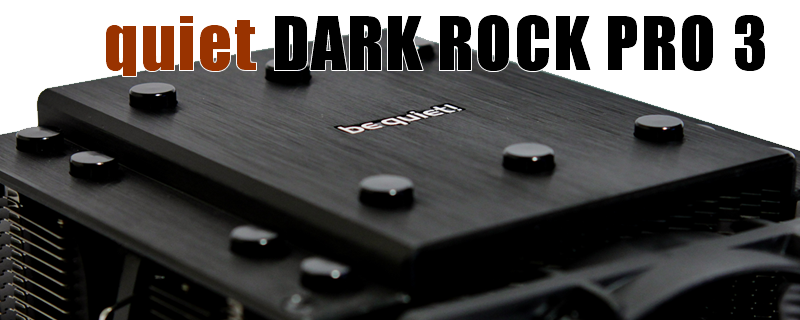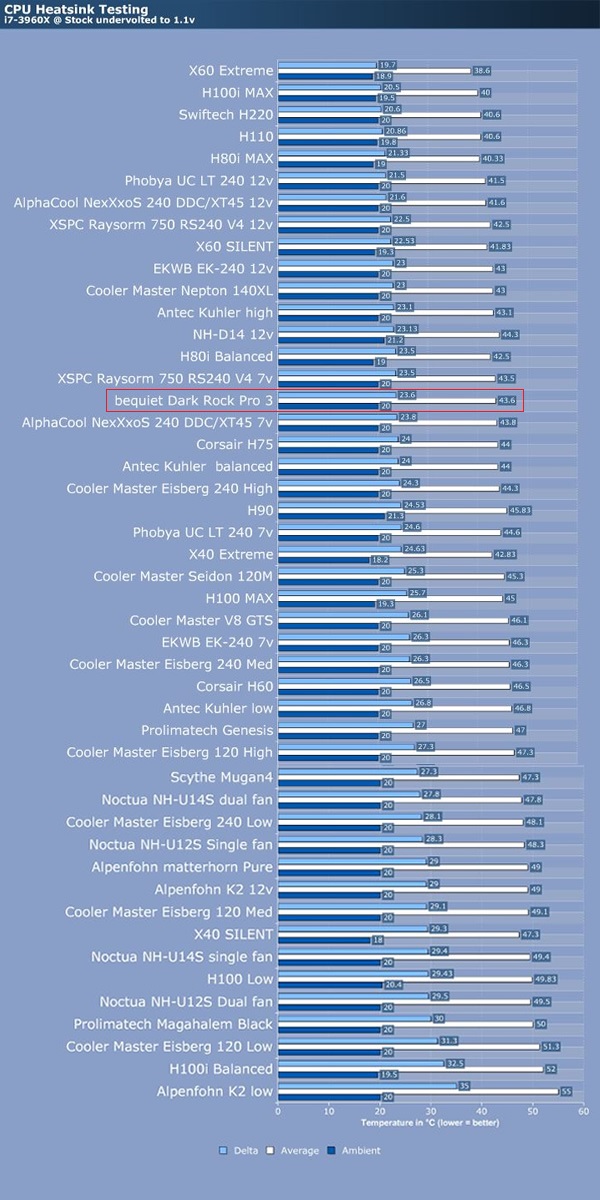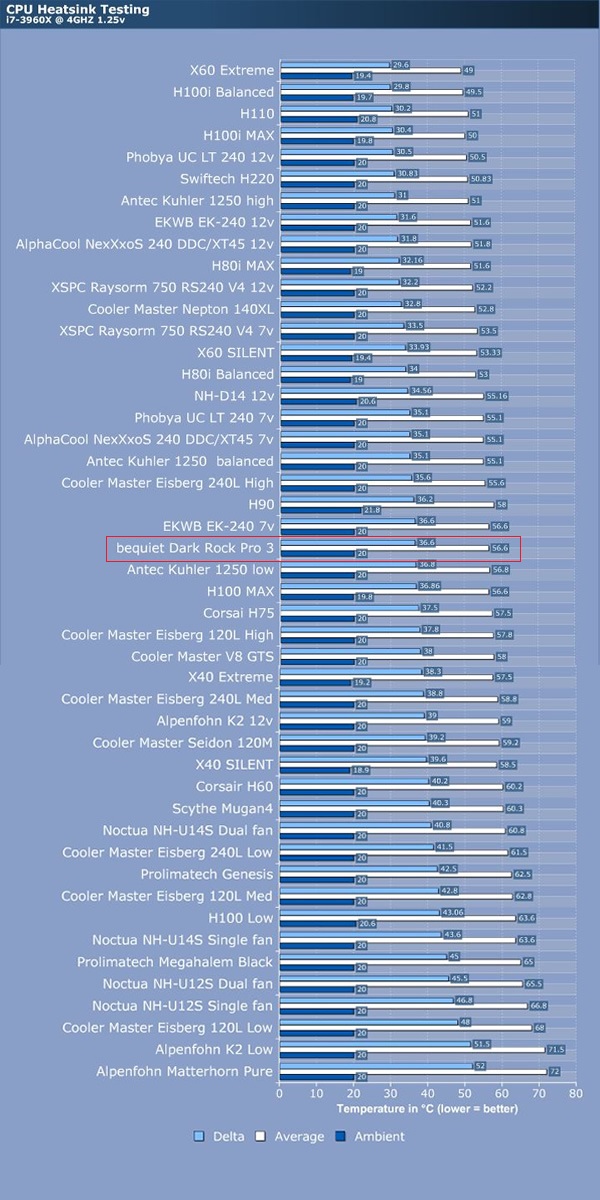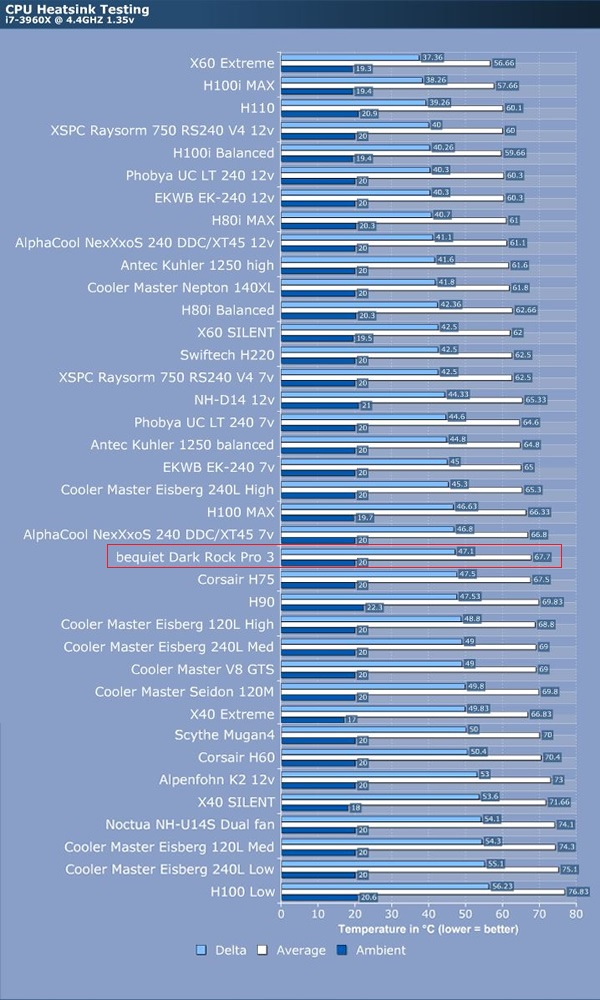bequiet Dark Rock Pro 3 Review
Performance and Testing
We’ve changed the way we display our graphs in the hope that it makes it easier to gauge how well the item under review has performed in relation to the competition. We’ve ordered the contents with the best performing cooler at the top, and the worst at the bottom. The cooler under review is highlighted in red within the data set. We’ve also moved away from Flash so all you portable device users can feel the love.
Â
The test set up consisted of the following
Intel i7 3960X [email protected] 1.1v (undervolted) 4.0GHz @ 1.25v 4.4GHz @ 1.35v 4.6GHz @ 1.45v Gigabyte X79 UD3 Corsair Vengeance LP Memory Corsair HX850 V2 Corsair Force GT 60GB Coolermaster Storm Trooper.Â
As usual we’ll be testing our coolers at varying levels of overclock and increasing levels of voltage. this in turn of course means increasing levels of heat which the coolers need to dissipate. To begin with we start with the undervolted stock speed. Why undervolted? well if you have things set on “Auto”, you may well be using more volts than are actually required to run at the chosen frequency, for example our 3960s will run quite happily at just 1.1volts, solid as a rock, 24/7, and as such we use this as our starting point.
Continuity is very important in testing, and for this reason we keep as many of the potential variables as locked down as possible. We will be using OCCT in Linpack X64, AVX compatible with all logical cores tested and 90% free memory utilised. The test is set up to run automatically with just a few clicks to set it going. A 10 minute idle followed by 30 minutes of testing and a 5 minute cool down is the order of the day and brings the total test time per clock speed to 45 minutes. So as to remove subjectivity in determining whether a CPU has failed, OCCT is set to stop the test and register a fail should the max temp exceed 80 degrees. In testing we noted that if even just one of the cores exceeds 82 degrees OCCT halts the test and a fail is recorded.
The bequiet Dark Rock Pro 3 doesn’t come with any low noise adapters or fan speed reducers so the testing was a relatively simple and quick process, simply fit it and fire up the tests.
With a Delta temp of just 23.6 at stock thePro3 is only a smidge behind the mighty D14. Not bad!  However, these low volt low overclocks are not where the action’s at though and aren’t tha much of an indicator as to how well a cooler will cope once the volts have been cranked up, so let’s wind things up a bit.
Â
Turning now to the 4GHz test we up the voltage to 1.25 volts, this is what is deemed normally as stock volts. Something we are always harping on about on the forums is AUTO does not mean stock volts, and normally if you overclocking with “auto” volts the motherboard will be upping the volts much more than needed if you were to do it manually. By whichever means it happens, upping the volts (especially from our 1.1v undervolt) does have a big impact on temps, with an average increase of 10-15 degrees seen in the results.
At the higher levels of heat generated by the increase in voltage required for the 4.0GHz overclock, fan performance, although still a factor becomes less critical, replaced instead by a coolers ability to conduct the heat up the heat pipes and more crucially the total surface area of the fins enabling convection to the atmosphere. In the case of AIOs and water cooling the surface area of the radiator and the efficiency of the contact plate begin to play more of a factor. The Pro 3 is still making a reasonable fist of things, fair enough it’s lagging behind the D14 but this is to be expected. Other than that it’s top dog air cooler
Â
 Upping the volts still further we achieve a stable 4.4GHz overclock at 1.35 Volts. It’s here we start to separate the wheat from the chaff, with lesser coolers not able to disperse the increased heat effectively. Again we see a jump of 10 degrees or so from the figures at 4GHz. Both the H100 and the well-respected D14 are creeping into the 70s here, indicating that only the cream of the crop will excel at this level.Â
This is where we start to separate the men from the boys, and we’re pleased to see the Pro 3 is not only still in there, but actually still placed second behind the D-14 with regards to Air coolers. Not only tha but it’s betering quite a few of the 120mm rad based AIOs such as the H75 and Seidon 120
Â
The Pro 3 didn’t pass our 4.6GHz test, failing after about 12 mins. Fair enough, neither did the D14 Â






